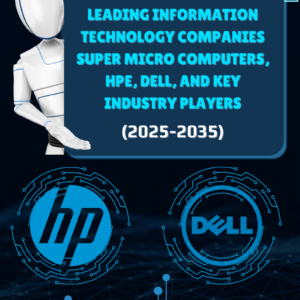1. Executive Summary:
-
- Overview of the IT infrastructure monitoring software market in Europe
- Key insights into vendor usage and selection criteria
- Top trends shaping the IT monitoring landscape
2. Current Providers: A Snapshot of Vendor Utilization:
-
- Leading IT Monitoring Software Providers in Europe:
- Popular providers (e.g., SolarWinds, PRTG, Nagios, Zabbix, Datadog, etc.)
- Market penetration by vendor and region
- Customer Insights:
- Breakdown of vendor usage among different company sizes and industries
- Preferences for open-source vs. commercial solutions
- Case Studies:
- Example 1: Large enterprise using Datadog for hybrid cloud monitoring
- Example 2: Mid-market company leveraging PRTG for on-premise infrastructure
- Leading IT Monitoring Software Providers in Europe:
3. Selection Process for IT Infrastructure Monitoring Solutions:
-
- Role in the Selection Process:
- Stakeholders involved in decision-making (IT, procurement, executive leadership)
- Cross-functional teams and their influence on vendor selection
- Technical expertise and procurement collaboration
- Key Purchasing Criteria (KPC):
- Scalability and flexibility of the solution
- Ease of integration with existing IT stack
- Cost-effectiveness and pricing models (subscription vs. perpetual licenses)
- User interface and ease of use
- Customizability and modularity of the platform
- Vendor support, reliability, and service-level agreements (SLAs)
- Vendor Evaluation Methods:
- Proof of concept (PoC) testing
- Reference checks and industry peer reviews
- Benchmarks and performance assessments
- Role in the Selection Process:
4. Modules in Use: A Breakdown of Popular Functionalities:
-
- Common Modules in IT Infrastructure Monitoring Solutions:
- Network Monitoring:
- Real-time performance tracking, traffic analysis, and bottleneck identification
- Server Monitoring:
- Monitoring CPU, memory, disk usage, and server availability
- Cloud Infrastructure Monitoring:
- Usage in multi-cloud and hybrid cloud environments (e.g., AWS, Azure, GCP)
- Application Monitoring:
- End-to-end application performance and user experience tracking
- Security and Compliance Monitoring:
- Monitoring for vulnerabilities, threats, and regulatory compliance
- Log Management and Analytics:
- Centralized log collection, analysis, and anomaly detection
- Network Monitoring:
- Customer Feedback on Modules:
- Which modules provide the most value?
- Emerging trends in modularity and flexibility of monitoring solutions
- Common Modules in IT Infrastructure Monitoring Solutions:
5. Challenges in IT Infrastructure Monitoring:
-
- Key Customer Pain Points:
- Complexity in multi-cloud and hybrid infrastructure monitoring
- Scalability challenges with growing infrastructure
- Managing alerts and reducing false positives
- Integration with other IT service management (ITSM) tools
- Lessons Learned from Implementation:
- Best practices in deploying monitoring software
- Overcoming initial setup challenges and scaling the solution
- Successful change management during deployment
- Key Customer Pain Points:
6. Vendor Performance and Customer Satisfaction:
-
- Performance Metrics for IT Monitoring Providers:
- Uptime, scalability, support responsiveness, and feature enhancements
- Customer Satisfaction and Service Quality:
- User satisfaction scores by vendor
- Feedback on after-sales support and service-level consistency
- Performance Metrics for IT Monitoring Providers:
7. Emerging Trends in IT Infrastructure Monitoring:
-
- AI and Machine Learning Integration:
- Predictive analytics and anomaly detection using AI
- Automation in IT monitoring and self-healing systems
- Monitoring as a Service (MaaS):
- The rise of cloud-native monitoring tools and their impact on traditional models
- Sustainability and Energy Efficiency Monitoring:
- Focus on tracking carbon footprints and energy usage in data centers
- AI and Machine Learning Integration:
8. Strategic Recommendations for IT Teams:
-
- Choosing the Right Monitoring Solution:
- Tailoring vendor solutions based on infrastructure needs
- Balancing cost with scalability and functionality
- Vendor Management and SLA Optimization:
- Ensuring vendors meet agreed-upon SLAs and performance standards
- Negotiating flexible contracts for evolving IT environments
- Choosing the Right Monitoring Solution:
9. Future Outlook for IT Infrastructure Monitoring in Europe:
-
- Projected Market Growth:
- Expected adoption rates across various industries
- Technology Advancements:
- Anticipated evolution in monitoring solutions over the next 5 years
- Regulatory Considerations:
- Data privacy laws (e.g., GDPR) impacting monitoring strategies and vendor selection
- Projected Market Growth:
10. Appendices:
-
- Glossary of terms (e.g., SLAs, PoC, etc.)
- List of top IT infrastructure monitoring vendors in Europe
- Vendor comparison matrix (features, pricing, scalability)
#ITInfrastructureMonitoring #MonitoringSoftware #ITMonitoring #VendorSelection #CloudMonitoring #NetworkMonitoring #ApplicationMonitoring #DataCenterMonitoring #ITSM #AIinMonitoring #MultiCloud #PredictiveAnalytics #ITTrends #Sustainability #CustomerSatisfaction




